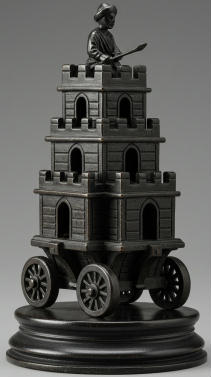Slip Rook
Historical Notes

The Slip Rook is a piece that can move similarly to a Rook, but only an odd number of squares. It can more precisely can be thought of as a bent rider, making its first step as a Wazir, and optionally continuing its move as a Dabbabah-rider. The piece is sometimes also referred to as a Panda, probably referring to its colorswitching move. It was used in a few problems in The Problemist in the 1970's. Later, George Jelliss gave it the name of Slip Rook. As Jelliss says in an article called Simple Chess Variants,
Another type of partial line pieces are Slip-pieces which derive from a line-rider by passing over the 3rd, 5th, 7th, etc cells in the ride. The Slip-rook was introduced by David Parlett under the name Panda. It is a rook that moves only to squares of opposite colour to that on which it stands.
Games it was used in include:
- the Seeping Switchers (experimental CwDA-army by Jörg Knappen)
- Commedia dell'Arte Chess (by Charles Gilman)
- GraTiA (by Charles Gilman)
- Rook Mania (Jared B. McComb)
Value
On a standard board, it is valued to be somewhat less than 3 pawns.
Movement
The Slip Rook, which is depicted as a bear on g7, for example can continue to g8, and from there to g10 and then to g12. (but only if g8 and g10 are empty). The most used version of it can leap over unreachable squares, so it can continue that way even if there are pieces on g9 and g11.

Related Pieces
Compounds were used in Sloppy Slippers (with Ferz), Commedia dell'Arte Chess (with Bishop and another one with Slip Bishop), and Seenschach (with Knight).
 This 'user submitted' page is a collaboration between the posting user and the Chess Variant Pages. Registered contributors to the Chess Variant Pages have the ability to post their own works, subject to review and editing by the Chess Variant Pages Editorial Staff.
This 'user submitted' page is a collaboration between the posting user and the Chess Variant Pages. Registered contributors to the Chess Variant Pages have the ability to post their own works, subject to review and editing by the Chess Variant Pages Editorial Staff.
Author: Kelvin Voskuijl and Fergus Duniho. Inventor: David Parlett.
Last revised by Fergus Duniho.
Web page created: 2025-04-12. Web page last updated: 2025-04-19